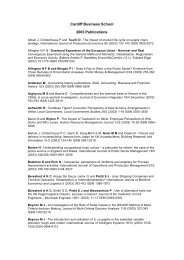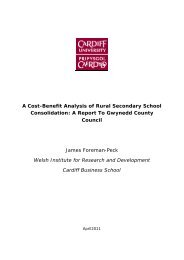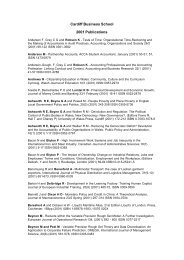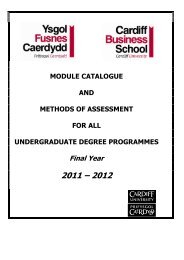Revisiting the Great Moderation using the Method of Indirect Inference
Revisiting the Great Moderation using the Method of Indirect Inference
Revisiting the Great Moderation using the Method of Indirect Inference
You also want an ePaper? Increase the reach of your titles
YUMPU automatically turns print PDFs into web optimized ePapers that Google loves.
Figure 1: Time Paths <strong>of</strong> Main Macro Variables <strong>of</strong> <strong>the</strong> US Economy<br />
(Quarterly data, 1972-2007)<br />
Nominal Fed rate Output gap CPI Ination<br />
Data source: <strong>the</strong> Federal Reserve Bank <strong>of</strong> St. Louis (http://research.stlouisfed.org/fred2/, accessed Nov. 2009).<br />
Fed rate and ination unltered; <strong>the</strong> output gap is <strong>the</strong> log deviation <strong>of</strong> real GDP from its HP trend.<br />
derived from <strong>the</strong> rm's optimal price-setting behaviour, and a Taylor Rule approximating<br />
<strong>the</strong> Fed's monetary policy. Using simulated behaviour from models <strong>of</strong> this sort, a<br />
number <strong>of</strong> authors suggest that <strong>the</strong> US economy's improved stability was largely due to<br />
stronger monetary policy responses to ination (Clarida, Gali and Gertler, 2000; Lubik<br />
and Schorfheide, 2004; Boivin and Giannoni, 2006 and Benati and Surico, 2009). The<br />
contrast is between <strong>the</strong> `passive' monetary policy <strong>of</strong> <strong>the</strong> 1970s, with low Taylor Rule<br />
responses, and <strong>the</strong> `active' policy <strong>of</strong> <strong>the</strong> later period in which <strong>the</strong> conditions for a unique<br />
stable equilibrium (<strong>the</strong> `Taylor Principle') are met, <strong>the</strong>se normally being that <strong>the</strong> ination<br />
response in <strong>the</strong> Taylor Rule be greater than unity. Thus it was argued that <strong>the</strong><br />
indeterminacy caused by <strong>the</strong> passive 1970s policy generated sunspots and so <strong>the</strong> <strong>Great</strong><br />
Acceleration; with <strong>the</strong> Fed's switch this was eliminated, hence <strong>the</strong> <strong>Great</strong> <strong>Moderation</strong>.<br />
By contrast o<strong>the</strong>r authors, mainly <strong>using</strong> structural VAR analysis, have suggested that<br />
<strong>the</strong> <strong>Great</strong> <strong>Moderation</strong> was caused not by policy regime change but by a reduction in <strong>the</strong><br />
variance <strong>of</strong> shocks. Thus Stock and Watson (2002) claimed that over 70% <strong>of</strong> <strong>the</strong> reduction<br />
in GDP volatility was due to lower shocks to productivity, commodity prices and forecast<br />
errors.<br />
Primiceri (2005) argued that <strong>the</strong> stagation in <strong>the</strong> 1970s was mostly due to<br />
non-policy shocks.<br />
A similar conclusion was drawn by Gambetti, Pappa and Canova<br />
(2008), while Sims and Zha (2006) found in much <strong>the</strong> same vein that an empirical model<br />
with variation only in <strong>the</strong> variance <strong>of</strong> <strong>the</strong> structural errors tted <strong>the</strong> data best and that<br />
alteration in <strong>the</strong> monetary regime|even if assumed to occur|would not much inuence<br />
5








